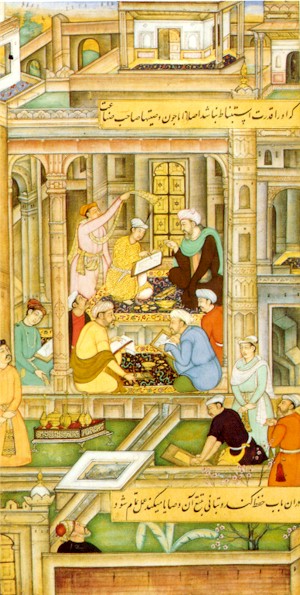|
Bangladesh came to today's shape through a long history of political
evolution. Bengal was probably the wealthiest part of the subcontinent up till the 16th
century. The area's early history featured a succession of Indian empires,
internal squabbling, and a tussle between Hinduism and Buddhism for dominance.
All of this was just a prelude to the unstoppable tide of Islam which washed
over northern India at the end of the 12th century. Mohammed Bakhtiar Khalzhi from
Turkistan captured Bengal in 1199 with only 20 men.
Under the Mughal viceroys, art and literature flourished, overland trade
expanded and Bengal was opened to world maritime trade - the latter marking the
death knell of Mughal power as Europeans began to establish themselves in the
region. The Portuguese arrived as early as the 15th century but were ousted in
1633 by local opposition. The East India Company negotiated terms to establish a
fortified trading post in Calcutta in 1690.
The decline of Mughal power led to
greater provincial autonomy, heralding the rise of the independent dynasty of
the nawabs of Bengal. Humble East India Company clerk Robert Clive ended
up effectively ruling Bengal when one of the impetuous nawabs attacked
the thriving British enclave in Calcutta and stuffed those unlucky enough not to
escape in an underground cellar. Clive retook Calcutta a year later and the
British Government replaced the East India Company following the Indian Mutiny
in 1857.
The Britons established an organizational and social structure unparalleled
in Bengal, and Calcutta became one of the most important centers for commerce,
education and culture in the subcontinent. However, many Bangladeshi historians
blame the British dictatorial agricultural policies and promotion of the
semi-feudal zamindar system for draining the region of its wealth and
damaging its social fabric. The British presence was a relief to the minority
Hindus but a catastrophe for the Muslims. The Hindus cooperated with the Brits,
entering British educational institutions and studying the English language, but
the Muslims refused to cooperate, and rioted whenever crops failed or another
local product was rendered unprofitable by government policy.
|
|
|
|

|
At the closure of World War II it was clear that European colonialism had run
its course and Indian independence was inevitable. Independence was attained in
1947 but the struggle was bitter and divisive, especially in Bengal where the
fight for self-government was complicated by internal religious conflict. The
British, realizing any agreement between the Muslims and Hindus was impossible,
decided to partition the subcontinent. That Bengal and Punjab, the two
overwhelmingly Muslim regions, lay on opposite sides of India was only one
stumbling block. The situation was complicated in Bengal where the major cash
crop, jute, was produced in the Muslim-dominated east, but processed and shipped
from the Hindu-dominated city of Calcutta in the west. Inequalities between the two regions
i.e. East and West Pakistan soon stirred up a sense of Bengali
nationalism that had not been reckoned with during the push for Muslim
independence. When the Pakistan government declared that `Urdu and only Urdu'
would be the national language, the Bangla-speaking Bengalis decided it was time
to assert their cultural identity. The drive to reinstate the Bangla language
metamorphosed into a push for self-government and when the Awami League, a
nationalistic party, won a majority in the 1971 national elections, the
president of Pakistan, faced with this unacceptable result, postponed opening
the National Assembly. Riots and strikes broke out in East Pakistan, the
independent state of Bangladesh was unilaterally announced, and Pakistan sent
troops to quell the rebellion.
The ensuing war was one of the shortest and bloodiest of modern times, with
the Pakistan army occupying all major towns, using napalm against villages, and
slaughtering and raping villagers. Bangladeshis refer to Pakistan's brutal
tactics as attempted genocide. Border clashes between Pakistan and India
increased as Indian-trained Bangladeshi guerrillas crossed the border. When the
Pakistani air force made a pre-emptive attack on Indian forces, open warfare
ensued. Indian troops crossed the border and the Pakistani army found itself
being attacked from the east by the Indian army, the north and east by
guerrillas and from all quarters by the civilian population. In 11 days it was
all over and Bangladesh, the world's 139th country, officially came into
existence. Sheikh Mujib, one of the founders of the Awami League, became the
country's first prime minister in January 1972 ; he was assassinated in 1975
during a period of crisis
The ruined and decimated new country experienced famine in 1973-74, followed
by martial law, successive military coups and political assassinations. In 1979,
Bangladesh began a short-lived experiment with democracy led by the
overwhelmingly popular President Zia, who established good relationships with
the West and the oil-rich Islamic countries. His assassination in 1981
ultimately returned the country to a military government that periodically made
vague announcements that elections would be held `soon'. While these
announcements were rapturously greeted by the local press as proof that
Bangladesh was indeed a democracy, nothing came of them until 1991. That year
the military dictator General Ershad was forced to resign by an unprecedented
popular movement led by the Bangladesh Nationalist Party and the Awami League.
Democracy was re-established and the economy ticked along at a 4.5% growth
rate, which hardly made it an 'Asian tiger' but was at least respectable. Political dog-fighting between the BNP and the Awami League became acrimonious
in the run up to national elections in February 1996 leaving the country
strike-ridden and rudderless. The election was marred by violence and boycotted
by the three main opposition parties, resulting in a BNP shoo-in. However, low
voter turnout and reports of ballot-box stuffing by polling officials raised
serious questions about the government's legitimacy and in April 1996 Prime
Minister Begum Khaleda agreed to stand down and appointed an interim caretaker
administration, pending new elections scheduled for 12 June 1996.In the elections
Awami League
got the largest
number of seats. Sheikh Hasina Wazed, the leader of the Awami League, was sworn in as the Prime Minister of
Bangladesh Government.
|
Bangladesh
Overview
National
Anthem
National
Flag
Constitution
Government
Capital
National
Icons
National
Media
Independence
War
History
Geography
Economy
Currency
People
Education
Art
& Culture
Language
Religion
Festivals
Transportation
Cities
Districts
Places of Interest
Websites
|




